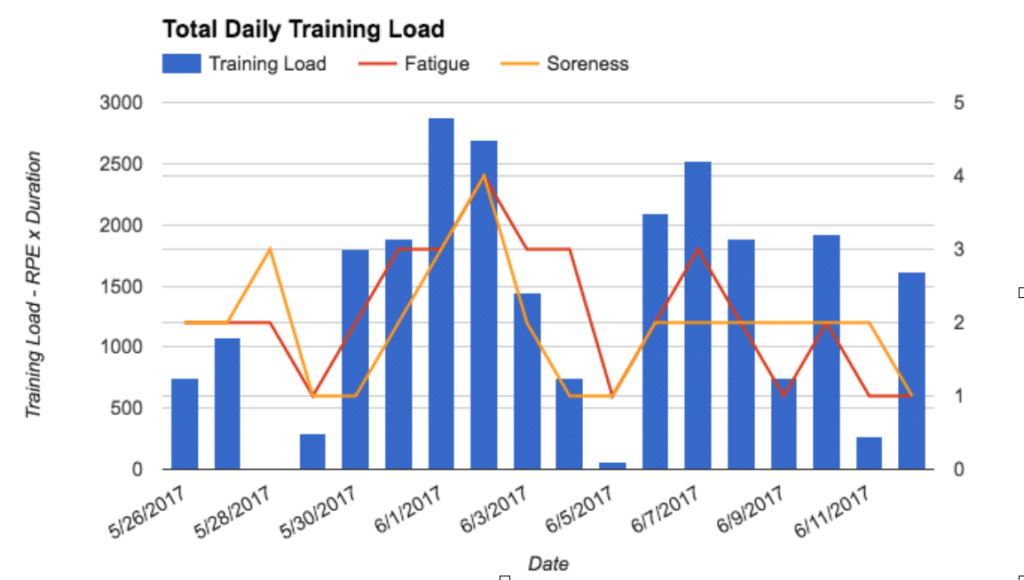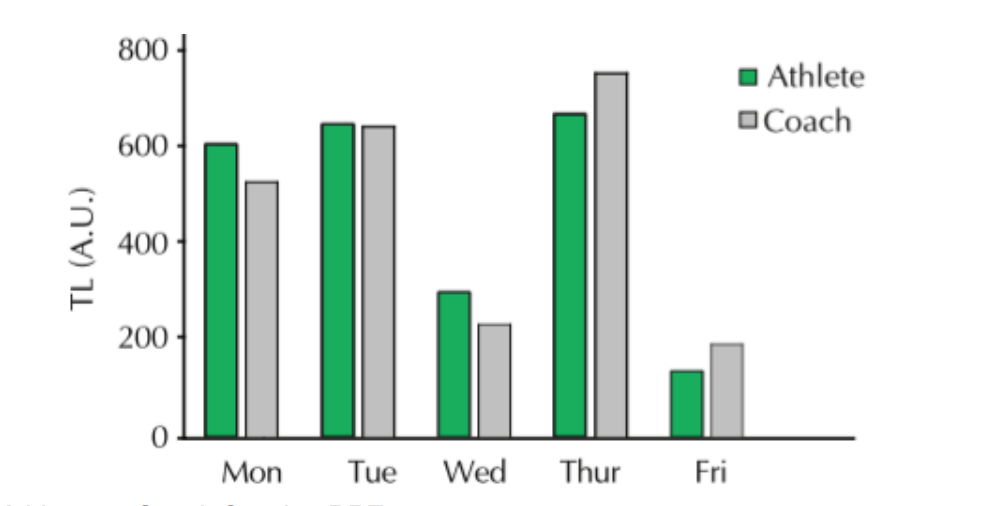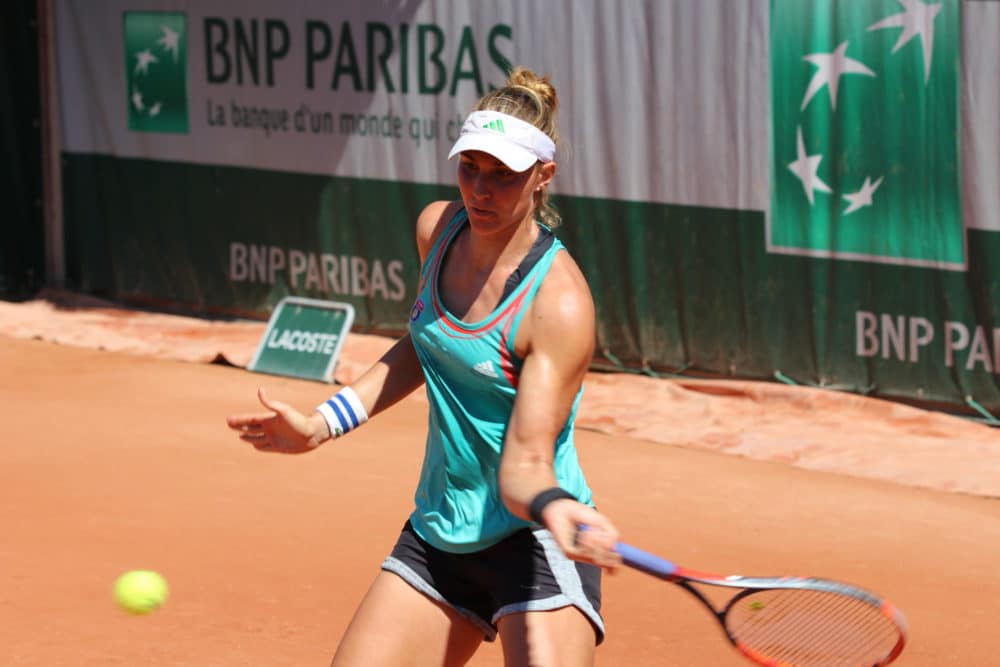There’s no secret that tennis is demanding. How demanding? That’s tough to say. I mean, how do we measure the intensity and stress of a practice or match? Furthermore, what about all the other things players do to prepare for competition – like weight training, plyometrics, med ball exercises, stretches and more!?! Traditionally, time on court has been the go to method – but does this provide us with enough info? Many of us would assume that a 3-set match is physically demanding…but what if the score was 6-1, 2-6, 6-2 and finished in an hour and a half? Is that different than a match that goes over 3 hours with a score like this: 6-4, 6-7, 7-6? These 2 scenarios are vastly different! A similar dilemma exists in practice. One player goes all out while the other is holding back. It’s no different in the gym. A high volume day feels and looks different than a low volume/high intensity day.
You may be wondering why this important anyway? Well, knowing the stress that training has on players can provide useful information for both the coach and the athlete. It may help the design of future sessions and at the same time, mitigate injury, overtraining and burnout. In this post, we’ll outline the importance of monitoring training load, how to measure it and then how to apply it with your players.
WHY IS MONITORING TRAINING LOAD IMPORTANT?
First off, it’s impossible for players to practice at full intensity every time they step on the court. It’s actually a bit frustrating to see coaches yelling at players to have more intensity – not only from a physical standpoint, but mentally and emotionally. This constant high-intensity training is exhausting…and as we’ll see later, exhaustion should never be the goal of a practice session.
Although periodization – dividing training into distinct phases – has gained popularity in mainstream fitness, the classical approach doesn’t quite hold true in modern sport. There are simply too many competitions and too much at stake in each outing to plan to peak only a few times a year. A WTA player, for example, surely wants to peak for the majors (4 times per year) but then there are premium tour events and even lower tier events that are also important – and may decide whether they get into a Grand Slam to begin with! That said, science (and high performance coaches) consistently tell us that some sort of variation in training load DOES in fact lead to elite performances. This is likely due to it’s effects on recovery (needed for a training adaptation to occur), the management of fatigue, and its influence on preventing stagnation & overtraining.
There are a number of theories that attempt to explain the adaptation process. One that has a sound theoretical underpinning is the fitness-fatigue model (Zatsiorsky 1995). This theory proposes that an athlete’s preparedness for their sport is the summation of fitness and fatigue. In other words, training should lead to better fitness (through the body’s adaptive processes) but at the same time, training can also be fatiguing (temporarily diminishing performance).
The interaction between fitness and fatigue must be managed appropriately so that fitness outweighs fatigue – otherwise training is all for not. This is perhaps why many players get burnt out, or incur injury. They, along with their coaches, believe that more training & competition is the answer. But, it’s likely the variation in training load that will lead to elite performances, not the number of hours spent on court or in the gym. Tracking & monitoring daily training load can help coaches better manage their players so they can at least have a better chance at optimizing performance at the right moments.
HOW TO MONITOR TRAINING LOAD?
Many team sports have recently adopted global positioning satellite systems (GPS), accelerometers and other tracking devices to monitor (and help prescribe) training loads. These are considered external-load measures. The opposite, called internal-load measures, would include such physiological markers as salivary blood, heart rate and oxygen consumption measurements. Although many studies have reported that these measures (both external and internal) are reliable and valid, they are often expensive and impractical – especially in tennis settings where many weeks of travel are involved.
Traditionally, tennis coaches have used weekly or daily court time as a measure of training load. Even the ITF (International Tennis Federation) provides hour based recommendations for players & coaches based on their level of play and training phase (preparation or competition). Unfortunately, this form of monitoring is inadequate. Why? It does in no way account for session intensity. Is a 1 hour training session where a player stands in a corner and hits balls the same as a 1 hour session where a player runs through multiple high-intensity drills? Hardly. What about a 30 min serving session that focuses on speed versus a 30 min serving session that focuses on technique? Not the same either. These are just examples of scenarios that place vastly different physical stressors on a player….and should therefore be accounted for.
Enter the RPE (rating of perceived exertion) scale. You may have heard of the RPE scale in other settings (running being one of them). Once you finish a run, you’re asked, ‘how hard was that run for you” and you respond with a rating between 1 and 10. Here’s what it looks like:
Rating Descriptor
0 = Rest
1 = Very, very easy
2 = Easy
3 = Moderate
4 = Somewhat hard
5 = Hard
6 = –
7 = Very Hard
8 = –
9 = –
10 = Maximal
Beyond 10 would be absolute physical exhaustion – probably what most players feel like after a long match in the heat (some players actually do reach exhaustion and faint on court). In training, it’s never recommended to take an athlete to this point. But this is another issue altogether – learn more here.
Now that we have a measure of intensity, we can combine the session rating with the total duration of that session to get a measure of total training load. For example, if I practice for 120 minutes and my RPE rating was 7 I would simply multiply the 2 results (120 x 7 = 840). This score of 840 would be called the ‘Session Training Load’ and the actual values are recorded as ‘arbitrary units’ (AU). Again this provides a training load for that particular session. This can be taken one step further to look at the training load across an entire week, simply by adding all the session RPE’s for that week. Over the course of a year you’ll get a pretty good idea of the training load imposed on your athlete.
With my athletes, I take it one step further. I simply ask them how training felt, overall, for the entire day. This includes all sessions of tennis and fitness combined and is then multiplied by the TOTAL duration of time spent training on that particular day. Over the course of a long season, having to fill out forms after every practice and fitness session can get stale. Having athletes give a number for the whole day still provides insight into the difficulty of that day for them. I also ask them a few other simple questions. Including, “how sore do you feel today” and “how fatigued do you feel today”. I then chart the results. Here’s an example:

As you can see, soreness and fatigue often follow training load (although it’s not always the case). Tracking other variables that may be important to you and your athlete is also a good idea. Good contributors to stress include sleep, hydration, nutrition, emotional stress, menstruation for female athletes, and so on. These would all be worth tracking.
WHAT DOES THE RESEARCH ON RPE TELL US?
A research group (Coutts et al 2010) tested the session RPE theory in a tennis specific setting. In 2008, they recorded the session RPE of a top 80 player leading up to, and during, Roland Garros (arguably the most physically demanding tournament of the calendar year). Table 1 below reflects the session RPE ratings for both the player AND the coach the week prior to the event.

Table 1 – Athlete vs. Coach Session RPE
Asking both the coach and player about session RPE was deliberately done to analyze any discrepancies between the two. I.e. is the athlete perceiving what the coach is prescribing? As you can see, there’s only 1 training day where both the coach and the athlete had a similar assessment of the session intensity – the duration of practices was of course constant so the different training load scores can only be attributed to intensity. If we assume that day 1 of training (Monday), they performed a 120 minute session, then the discrepancy in intensity is 2 levels from one another (6 for the athlete and about 4 for the coach). This is quite significant, as 6 represents close to ‘very hard’ while 4 is only ‘somewhat hard’ (look at rating chart again).
This is not an uncommon occurrence. Murphy et al (2014) – a research group that works closely with Tennis Australia – found that coaches significantly underestimate an athlete’s session RPE. If this is a trend across many settings, then perhaps as coaches, we’re placing too much stress on athletes without even knowing it!
Furthermore, look at table 2. This is the session RPE of the top 80 player during Roland Garros. The general trend seems to point to increased duration equaling increased perceived difficulty. This is not always the case, as I can attest to from experience, but having this info can help coaches and players with their future practice planning.

Table 2 – Session RPE During Competition
WHY IS SESSION RPE SUCH A VALUABLE TOOL?
As a coach, whether you prescribed a tough session or not, knowing how your player perceived that session provides extremely useful information in designing and planning subsequent sessions. In the above example, if the coach thought the session was only a 4/10 and didn’t know that the athlete perceived it as harder than that, he may plan more and more difficult sessions as the week progresses.
This info also gives the coach an indication of the intensity of matchplay. Many sport scientists have written over the years about maximal intensity in training versus maximal intensity in competition. While it’s possible to make practices extremely intense, according to these pioneers (and I tend to agree), nothing can compare to the intensity of competition. The tension, stressors and heightened focus/awareness are just a few factors that contribute to the equation and nothing but competition can relate. Practice matches might come close, which is why they’re so vital in the preparation of an elite player, but not close enough. Tracking matchplay is huge and every player/coach should be doing it.
OTHER PRACTICAL IMPLICATIONS
Adopting this type of monitoring approach might be easier in certain settings than others. For instance, a pro player has more flexibility in their training schedule versus a junior who plays in an academy. But getting some sort of training load value, in my opinion, is an absolute must! Players that have similar training intensity goals for the day can then practice together, so that one isn’t being forced to play hard when in fact it should be a lighter day, and vice versa. This is often what happens on tour. Players look for practice partners that are in similar scenarios physically..
Session RPE is by no means the only way to measure training load – other questionnaires can also do the trick. There are also specific mental questionnaires (like the ‘Mental Exertion Rating’) that are likewise extremely beneficial. More advanced GPS and tracking devices can also be useful, but like I mentioned previously, they aren’t particularly practical. Questionnaires are a low cost, reliable, repeatable and valid way to get detailed info from your players.
Although not the topic of this article, it’s worth mentioning that optimizing recovery (so players can train more frequently and with greater overall intensities) can be achieved through several specific recovery modalities – like stretching, contrast baths/showers, electrical stimulation etc. Before attempting these modalities, there are other, more important recovery strategies including proper nutrition, good sleeping habits and sound programming – this is where monitoring plays an integral role.
Mattspoint – Is a tennis training resource for coaches & players, including the latest in sport science research & training videos. Coach Matt Kuzdub offers on and off court tennis training to maximize performance & prevent injury.
Follow on Facebook
IF YOU ENJOYED THIS POST, PLEASE SHARE IT ON FACEBOOK AND TWITTER. ESPECIALLY WITH PLAYERS & COACHES. THANKS!

